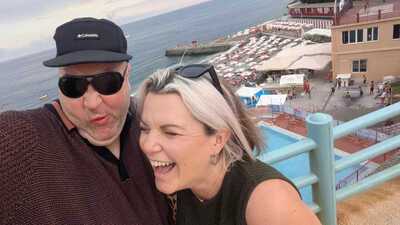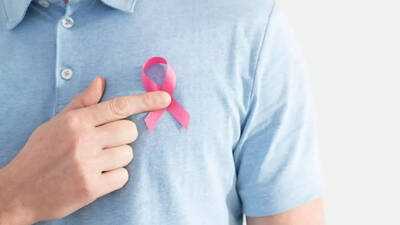Breast cancer, one of the most aggressive kinds of cancer, remains the most commonly diagnosed cancer among women globally. In 2022 alone, according to the World Health Organization, around 2.3 million women were diagnosed with the disease, and approximately 670,000 died.
While breast cancer remains a serious health concern in women, we often think that men are immune to this disease — quite a misleading notion. Although breast cancer in men remains a rare condition, that rarity doesn’t confirm the impossibility of it.
A 42-year-old chef’s story might convince you to pay attention.
What happened
Matt Kelly, a 42-year-old US chef, first noticed a lump in his chest in October last year while working on a restaurant launch in Chicago. He reportedly ignored the lump at first, assuming it was benign or related to his busy lifestyle. Ultimately, at the insistence of his wife, Kelly did visit the doctor, who advised further tests to “push for progress and answers," and the diagnosis arrived just two days before Christmas.
Kelly was diagnosed with an aggressive form of male breast cancer . A few more tests, which included a PET scan, revealed the cancer had spread to his lymph nodes and bones, predominantly his spine.

Even though Kelly’s cancer is now incurable, as reported by The Independent, he has started taking a targeted therapy drug, which is helping him “keep the cancer at bay while living life to the fullest”.
Kelly shared with The Independent, “I’m currently in a state of cancer limbo, where I have no metabolic sign of cancer, but the only thing keeping it at bay is the treatment. I’m on chemo for the rest of my life every three weeks, but currently, I have no form of cancer within me, so I’ve had an amazing response to it.”
Kelly is now urging men everywhere to “regularly check their chests” and not delay even when symptoms seem small or harmless.
Breast cancer in men: How common is it
Kelly’s experience highlights how easily male breast cancer can go unnoticed — especially in younger men and those who don’t see themselves at risk.
Breast cancer in men occurs when malignant (cancerous) cells develop in the breast tissue of a male. Although men have much less breast tissue than women, they still possess ducts and some breast tissue, so cancer can arise.
In terms of prevalence, male breast cancer is rare, accounting for less than 1% of all breast cancer cases, according to the American Cancer Society. Because of this rarity, many men and their doctors may not immediately recognize the symptoms, which often leads to later-stage diagnosis. Notably, as male breast tissue is much smaller than female breast tissue, men’s cancers can be detected sooner, or conversely, more silently overlooked. Average age at diagnosis tends to be older (in the 60s), though cases in younger men, like the chef’s at 42, do happen.

Possible causes and key risk factors
While the exact cause of breast cancer in men often remains unclear, several risk factors increase the likelihood, such as:
Genetic changes: mutations in genes such as BRCA2 (and to a lesser extent BRCA1) are known to raise a man’s risk.
Hormonal imbalance: elevated levels of estrogen relative to androgens — common in conditions like liver disease, Klinefelter syndrome (having an extra X chromosome), or after certain hormone therapies — can increase risk in men.
Age: although the chef was 42 (younger than many male breast cancer patients), most cases occur in older men (60s and above), but that doesn’t mean that younger men are immune to it.
Medical history and lifestyle factors: Prior radiation exposure to the chest area (e.g., earlier treatment of another cancer) can be another known factor that could work as a trigger. Meanwhile, obesity, alcohol use, and lack of exercise may indirectly increase risk by altering hormone levels.
Early warning signs: Red flags to watch for
Because male breast cancer is rare, many men may ignore or misinterpret the slight changes that may amount to a delayed diagnosis. Whereas, knowing the key symptoms can prompt a timely medical evaluation:
A lump or swelling in the chest: Often spotted under, or around the nipple, or in the armpit, and more often than not, this lump is painless.
Nipple changes: Any kind of discharge (which may be clear or bloody), inversion (turning inward), scaly skin, or rash around the nipple might be a worrying indicator.
Skin changes: Men are conditioned to pay hardly any attention to their skin health, but dimples, puckering, redness, or even sudden thickening of the skin of the breast or chest area can be indicative.
Swollen lymph nodes: Found under the arm or near the collarbone, persistent for no obvious cause, these swollen lymph nodes can be a sign that the cancer has begun to spread.
Besides, any persistent change in the size or texture of the chest or breast area in a man should not be ignored. In the case of the chef, the initial lump wasn’t paid attention to until the cancer reached an aggressive stage — this should serve as a reminder that even a slight delay in recognizing symptoms poses a huge risk.
While breast cancer remains a serious health concern in women, we often think that men are immune to this disease — quite a misleading notion. Although breast cancer in men remains a rare condition, that rarity doesn’t confirm the impossibility of it.
A 42-year-old chef’s story might convince you to pay attention.
What happened
Matt Kelly, a 42-year-old US chef, first noticed a lump in his chest in October last year while working on a restaurant launch in Chicago. He reportedly ignored the lump at first, assuming it was benign or related to his busy lifestyle. Ultimately, at the insistence of his wife, Kelly did visit the doctor, who advised further tests to “push for progress and answers," and the diagnosis arrived just two days before Christmas.
Kelly was diagnosed with an aggressive form of male breast cancer . A few more tests, which included a PET scan, revealed the cancer had spread to his lymph nodes and bones, predominantly his spine.
Even though Kelly’s cancer is now incurable, as reported by The Independent, he has started taking a targeted therapy drug, which is helping him “keep the cancer at bay while living life to the fullest”.
Kelly shared with The Independent, “I’m currently in a state of cancer limbo, where I have no metabolic sign of cancer, but the only thing keeping it at bay is the treatment. I’m on chemo for the rest of my life every three weeks, but currently, I have no form of cancer within me, so I’ve had an amazing response to it.”
Kelly is now urging men everywhere to “regularly check their chests” and not delay even when symptoms seem small or harmless.
Breast cancer in men: How common is it
Kelly’s experience highlights how easily male breast cancer can go unnoticed — especially in younger men and those who don’t see themselves at risk.
Breast cancer in men occurs when malignant (cancerous) cells develop in the breast tissue of a male. Although men have much less breast tissue than women, they still possess ducts and some breast tissue, so cancer can arise.
In terms of prevalence, male breast cancer is rare, accounting for less than 1% of all breast cancer cases, according to the American Cancer Society. Because of this rarity, many men and their doctors may not immediately recognize the symptoms, which often leads to later-stage diagnosis. Notably, as male breast tissue is much smaller than female breast tissue, men’s cancers can be detected sooner, or conversely, more silently overlooked. Average age at diagnosis tends to be older (in the 60s), though cases in younger men, like the chef’s at 42, do happen.
Possible causes and key risk factors
While the exact cause of breast cancer in men often remains unclear, several risk factors increase the likelihood, such as:
Genetic changes: mutations in genes such as BRCA2 (and to a lesser extent BRCA1) are known to raise a man’s risk.
Hormonal imbalance: elevated levels of estrogen relative to androgens — common in conditions like liver disease, Klinefelter syndrome (having an extra X chromosome), or after certain hormone therapies — can increase risk in men.
Age: although the chef was 42 (younger than many male breast cancer patients), most cases occur in older men (60s and above), but that doesn’t mean that younger men are immune to it.
Medical history and lifestyle factors: Prior radiation exposure to the chest area (e.g., earlier treatment of another cancer) can be another known factor that could work as a trigger. Meanwhile, obesity, alcohol use, and lack of exercise may indirectly increase risk by altering hormone levels.
Early warning signs: Red flags to watch for
Because male breast cancer is rare, many men may ignore or misinterpret the slight changes that may amount to a delayed diagnosis. Whereas, knowing the key symptoms can prompt a timely medical evaluation:
A lump or swelling in the chest: Often spotted under, or around the nipple, or in the armpit, and more often than not, this lump is painless.
Nipple changes: Any kind of discharge (which may be clear or bloody), inversion (turning inward), scaly skin, or rash around the nipple might be a worrying indicator.
Skin changes: Men are conditioned to pay hardly any attention to their skin health, but dimples, puckering, redness, or even sudden thickening of the skin of the breast or chest area can be indicative.
Swollen lymph nodes: Found under the arm or near the collarbone, persistent for no obvious cause, these swollen lymph nodes can be a sign that the cancer has begun to spread.
Besides, any persistent change in the size or texture of the chest or breast area in a man should not be ignored. In the case of the chef, the initial lump wasn’t paid attention to until the cancer reached an aggressive stage — this should serve as a reminder that even a slight delay in recognizing symptoms poses a huge risk.
You may also like

6,801 beneficiaries in Chhattisgarh's Kanker to enter new homes on Nov 1

5 lakh 'Duplicate Voters' still in Bihar rolls, AAP's Sanjay Singh alleges

Family softens toward Tej Pratap as Rabri Devi backs his independent stand

'India prepared for Operation Sindoor 2.0': Army Chief Upendra Dwivedi

"Country remained secure from terrorist attacks except Jammu and Kashmir": Ajit Doval






